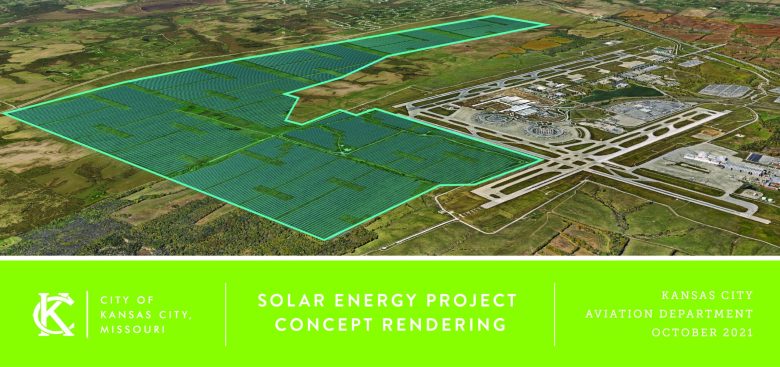Kansas City officials should know soon whether a second attempt to install solar panels at the city’s airport has wings.
A feasibility report is expected in the coming weeks for a plan to install a large solar array in a strip of city-owned land along the airport’s runways. City officials said the property could accommodate between 200 and 700 megawatts of solar capacity, though the size is likely to be around 300 MW.
The effort follows a canceled attempt last year to put panels on an airport parking ramp, and it comes amid a growing sense of urgency to meet the city’s climate and clean energy targets. The City Council postponed a 100% renewable energy goal for city operations to 2022 after missing its initial 2020 deadline.
“It’s going to take creative and innovative strategies if we’re ever going to make headway against climate change,” City Manager Brian Platt said. “We’re looking to lead by example — to be one of most sustainable and energy-efficient cities in the country.”
Platt began running city operations almost a year ago after serving as city manager in Jersey City, New Jersey. There, his team developed a 2.2-megawatt solar array that powers a public works facility and electric vehicle chargers.
The recent climate compromises in the federal reconciliation bill show why aggressive climate action at the local level is needed, Platt said. He’s optimistic about Kansas City’s chances to go big on solar power. One thing solar requires is a lot of space, and “one thing we have in Kansas City is land,” he said.
If successful on the scale Platt envisions, the airport solar project would be among the largest solar projects in the country and perhaps the largest one within a major city’s boundaries.

“Incredible” is how David Golembeski characterized the scope. He’s a program manager for the Interstate Renewable Energy Council. Cities typically have leased their land for arrays of 10 to 100 kilowatts, he said, but “more and more we’re seeing them above 1 megawatt.”
Besides providing power and reducing carbon emissions, Golembeski said large solar farms on public land can demonstrate to the community that “it’s not so scary” to go solar.
Platt thinks a solar project in the city’s backyard would help lower electricity costs and make its power system more resilient by reducing reliance on the broader power grid.
“We’re trying to take out the steps of where energy goes before it gets to your light switch,” he said. “If we can produce it here in Kansas City, that’s great.”
The city owns about 5,000 acres alongside and on the outer edge of two of the airport’s three runways. Development potential there is limited by strict height limitations, Platt said. One of the few viable uses — storage and distribution — is already under development on city land on the opposite side of the airport.
The feasibility study will address a wide range of questions, including how many of the acres are suitable for solar panels, how much power could be generated, what transmission and distribution investments would be needed, and whether glare would present a problem.
If it seems to be financially and technically doable, the city will need to make a partnership with the local utility, Evergy. The city could also decide to contract with a third-party solar company to develop the site and then sell the site or the power to Evergy.
Evergy spokesperson Gina Penzig said the company “has been in conversations with the city to explore solar at KCI and is aware of the feasibility study. Evergy is glad to offer information and support to our customers where appropriate when they are exploring sustainable energy goals. About half of the energy delivered to our customers is from emission-free sources and we are working to grow that.”
In the integrated resource plan it filed with state regulators earlier this year, the company said it intends to add 350 MW of solar capacity in 2023 and again in 2024.
Evergy and the city government abandoned plans for a 5-megawatt community solar array atop a six-story parking garage that will be part of a new airport now under construction. An engineering consultant warned that the project would create too much glare for air traffic controllers. The city is pursuing a community solar project elsewhere instead.
If glare becomes an issue again, Platt said he is confident of finding a solution, such as changing the orientation of the panels. He noted that airports across the country have devised ways to generate solar power.
“Unfortunately, all too often when things get difficult, everyone can point to reasons it won’t work,” Platt said. “But we in Kansas City are looking for the path to ‘yes,’ and the creative approach to solving these problems.”

